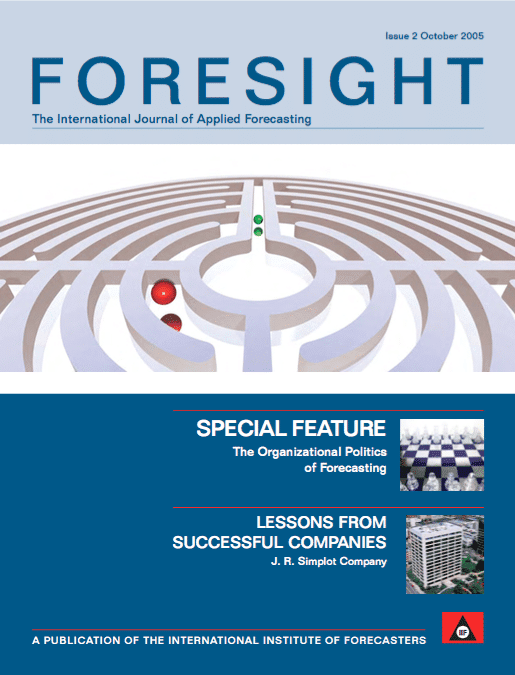FORESIGHT, Issue 2
$45.00
Description
Fall 2005 Issue
Special Feature: The Organizational Politics of Forecasting
- Introduction by Elaine Deschamps
In her introduction to this feature section, the goal is to examine some common problems that organizations face and provide solutions that allow the technically sound forecast to prevail, free of manipulation. - Six Steps to Overcome Bias in the Forecast Process by Elaine Deschamps
Aristotle wrote that “Man is by nature a political animal,” and human nature in the world of forecasting is no different from human nature in any other political environment. By addressing the organizational politics of forecasting, we are seeking to identify and ultimately overcome bias in the forecast process. - The Impact of Corporate Culture on Sales Forecasting by John Mello
Based on forecasting audits conducted in six companies and interviews with the corporate forecasters, John Mello distinguishes between the corporate values and strategies that benefit the salesforecasting process and those that undermine it. We may recognize our own organizations in his study and realize that we are on the right or wrong track. - How to Assess the Effect of Organizational Politics on the Efficiency of the Forecasting Process by Michael Gilliland
The forecasting process should deliver forecasts that are as accurate and unbiased as we can reasonably expect them to be, and deliver this “reasonable level of accuracy” as efficiently as possible.- Commentaries by: Donald Tynes and Emmet A. Jones
Articles
-
-
- Managerial Judgment: Best as an Input to the Statistical Forecasting Process by Rob Dhuyvetter
Rob Dhuyvetter shares his ideas and experience at the J.R. Simplot Company on the combining of statistical and judgmental forecasts. His main recommendation: rather than limit the use of managerial judgment to the adjustment of the outputs of statistical forecasting models, bring managerial judgment directly into the development of the statistical forecasting model. A key in doing this is timely communication with sales and marketing, and full documentation by sales and marketing of those assumptions they present to the forecasters and planners. - My Life as Soothsayer: 25 Years of Forecasting at British Telecom by Clive Mason
Clive Mason reflects on the changes that have taken place during his time as a forecasting practitioner at British Telecommunications PLC (BT) and its predecessors, back to and including the Post Office. He does not intend this paper to be a definitive study of forecasting methods in the telecommunications market. Rather, he focuses on the changes in the operating environment of BT over the last 25 years, considers the implications of these changes for forecasting practitioners, and examines the responses to challenges faced. He also discusses the evolution of the forecasting tool kit from simple graphical projection to automated systems. - To Include or Not To Include an Explanatory Variable: That is the Question by William M. Bassin
The addition of an explanatory variable to a regression model can increase its historical explanatory power but decrease forecast accuracy. The difficult decision is whether or not to use this explanatory variable in forecasting. The author shows how to decide on inclusion or exclusion. - A Primer on Forecasting with Neural Networks by Roy Batchelor
You’ve heard about neural-network forecasting models but probably have not considered them for your forecasting tasks. In this tutorial, Roy Batchelor demystifies neural networks, describing what neural networks do, when they seem useful as forecasting tools, and what the difficulties are with their use and implementation. - Demand Works Express 3.5: Filling a Gap in the Demand Planning Software Spectrum by Jim Hoover
In the current environment of enterprise demand-planning software, there is a sweet spot of opportunity for software solutions that provide a high level of demand-planning and forecasting capabilities, but do so at a price point that is affordable to small-to-medium-sized organizations. This article reviews such a product, Demand Works Express Version 3.5. - Book Review by Paul Goodwin
Collaborative Planning, Forecasting and Replenishment: How to Create a Supply Chain Advantage by Dirk Seifert - The War in Iraq: Should We Have Expected Better Forecasts? by Kesten C. Green and J. Scott Armstrong
- Managerial Judgment: Best as an Input to the Statistical Forecasting Process by Rob Dhuyvetter
-
.







